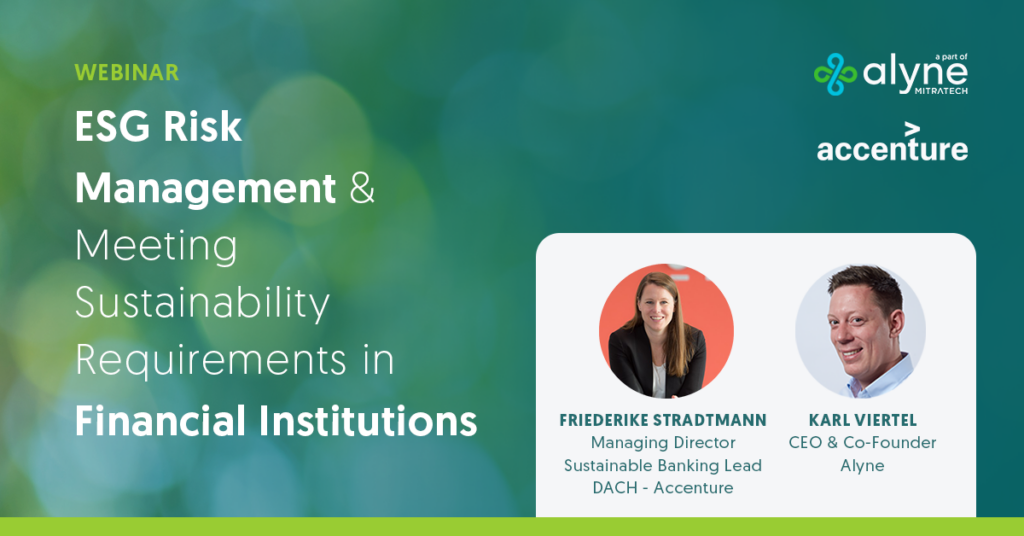It is clear by now that Environmental, Social and Governance (ESG) is more than just a marketing exercise and greenwashing is no longer a sufficient strategy, no matter the industry. As regulators across Europe, and around the world, focus more attention into ESG-labeled practices and products, it is evident that ESG risks play a much larger role in the overall risk exposure of the organisation than ever before. Incorporating them into your Enterprise Risk Management (ERM) can strengthen your organisation’s understanding of its full suite of risks and enhance overall business performance. ESG risks and Enterprise Risk Management (ERM) have a significant intersection. If you already have solid ERM processes in place, leverage these to address ESG risks as well. ESG GRC does not need to be a fundamentally new capability.
ESG requirements are becoming increasingly critical for many organisations, as regulators, investors and end consumers start to filter out companies that may not be aligned with positive ESG practices. The rising attention for ESG means that many organisations have to start incorporating associated risks into their Risk Management strategy in order to remain attractive to investors. A most interesting example of the previously stated, are financial services institutions. In Europe alone, the asset management industry has had to remove the ESG label from an estimated $2 trillion in assets between 2018 and 2020. Europe’s Sustainable Finance Disclosure Regulation (SFDR) imposes mandatory ESG disclosure obligations for asset managers and other financial markets participants with substantive provisions of the regulation, effective from 10 March 2021. The SFDR was introduced by the European Commission alongside the Taxonomy Regulation and the Low Carbon Benchmarks Regulation as part of a package of legislative measures arising from the European Commission’s Action Plan on Sustainable Finance. The SFDR aims to bring a level playing field for financial market participants and financial advisers on transparency in relation to sustainability risks, the consideration of adverse sustainability impacts in their investment processes and the provision of sustainability related information with respect to financial products. For financial services institutions this is a clear sign to act now, put the right processes in place and potentially review adequacy of the status quo. The business case on investment in ESG risk technology has clearly just changed – with higher cost of non-compliance and high reputational cost associated with being caught on the wrong foot.
How Alyne Can Help
Alyne has combined its powerful Risk Analytics and Assessment capabilities with expertly-curated ESG content. This provides a cutting-edge ESG Governance, Risk and Compliance (GRC) capability to enterprises. Apply this approach from the very beginning of your ESG program, right through to a fully quantified ESG Value at Risk.
Alyne’s ESG Risk Framework
The Alyne ESG Risk Framework consists of 16 ESG Megatrends. These have been further broken down into 95 additional sub-trends. This structure contains more than 300 individual data points.
- Climate Change
- Environmental Pressure
- Future of Work
- People and Values
- Democracy and Politics
- Privacy and Cyber
- Resource Scarcity
- Technology Advancement
- Shifting Economic Powers
- Poverty Reduction
- Digital Power Concentration
- Digital Inequality
- Human Rights
- Health
- Travel & Mobility
- Energy
Mapped ESG Frameworks
While no single framework has emerged as an industry standard, there are different relevant classifications and approaches. Firms are expected to follow the recommended disclosures to the extent that is necessary for all stakeholders to understand their ESG position, development and performance. As a result, we have selected three key standards to map the Alyne ESG Risk Framework to, to support corporate reporting based on these standards or classifications.
1. United Nations 17 Sustainable Development Goals
The United Nations have agreed on 17 key goals for sustainable development. These are to be reached by the year 2030. The 17 Sustainable Development Goals or 17 SDG were agreed in 2015 and serve as a good structure for analysing risks. Some organisations are guided by the structure for their reporting. On its own, the UN SDG is not a complete ESG framework to assess risks, however the enrichment of it through the Alyne Framework adds considerable value.
2. Sustainability Accounting Standards Board
The Sustainability Accounting Standards Board (SASB) has built an extensive framework of ESG risks. These are further broken down by individual industries. The focus is on measurability and comparability for sustainable finance decisions and accounting. The breadth can be overwhelming, but the structure is certainly helpful. We have mapped the SASB Materiality Dimensions and the General Issue Category to the Alyne ESG Risk Framework.
3. EU Sustainable Finance Taxonomy
The European Union Regulation 2020/852 on the establishment of a framework to facilitate sustainable investment has published a taxonomy. It is widely followed in the ESG sustainable finance industry. Article 9 of the act identifies six core environmental objectives:
- Climate Change Mitigation
- Climate Change Adaptation
- Sustainable Use and Protection of Water and Marine Resources
- Transition to a Circular Economy
- Pollution Prevention and Control
- Protection and Restoration of Biodiversity and EcosystemsAs a final note, when setting up an ESG Governance capability, there are some key elements that must be implemented:
- Clear Ownership
- Mitigation Strategies
- Prioritise Risk Data
- Reporting Structure
Watch our Webinar: “ESG Risk Management & Meeting Sustainability Requirements in Financial Institutions” for an expert discussion filled with unmissable insights between ESG experts from Alyne and Accenture.To learn more about Alyne’s ESG capabilities take a look at our supporting content here: from the latest episode of our talk show Morning Coffee to a fully dedicated White Paper and recent episodes of our podcast The RegTech Report.Contact us with any questions or inquiries, our team would be happy to hear from you.
